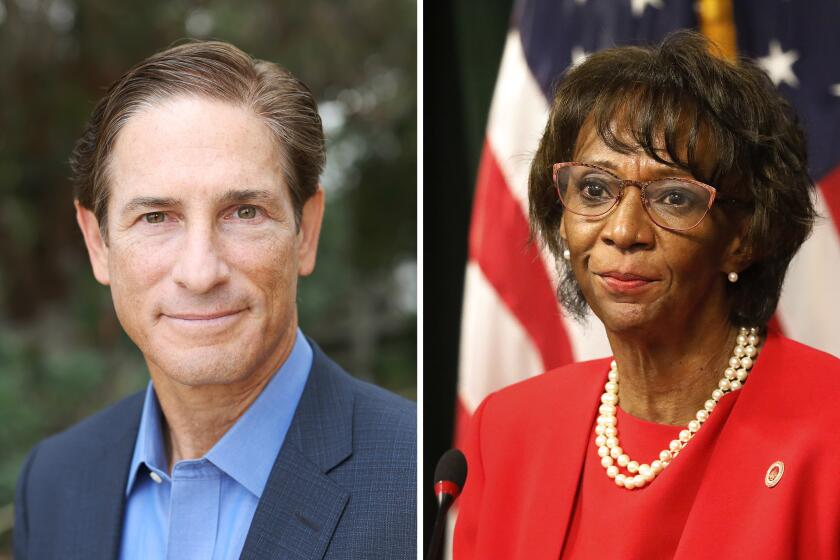3rd Trial of Beckwith for Evers Slaying Opens : Justice: Proceedings for 73-year-old Mississippi racist start 30 years to the day from start of the first.
Thirty years to the day after he first stood trial for the murder of Medgar Evers, 73-year-old Bryon De La Beckwith began a remarkable third trial Thursday that promises to relive the tension-filled days of the civil rights era.
Prosecutors described Beckwith, an unrepentant racist who claims he was 90 miles away on the night that Evers was shot, as a violent “coward” who waged a tireless one-man campaign against integration.
“He embarked upon a one-man war, a war to purge society of anyone and anything that was for integration,” said Bobby DeLaughter, the assistant district attorney whose dogged pursuit of the case over four years led to the new trial.
He told the jury of eight blacks and four whites that evidence in the trial will show that Beckwith killed Evers with “a bullet that was aimed out of hatred, propelled by prejudice and fired by cowardice, a back-shooting coward at night.”
Evers, the 37-year-old state field secretary of the NAACP, had angered segregationists by leading the crusade for civil rights in Mississippi, registering black voters and pressing to integrate the state’s schools and other public facilities.
He was killed by a bullet in the back shortly after midnight on June 12, 1963, as he returned home from a civil rights rally.
*
Beckwith, a fertilizer salesman whose rifle was found near the scene, stood trial twice in 1964, both times before all-white juries. Both juries deadlocked.
Beckwith, who wore a three-piece gray suit with a Confederate flag pin on the lapel, sat passively, yawned and nodded through most of the testimony Thursday.
Evers’ widow, Myrlie Evers, a retired Los Angeles public works commissioner, testified that she was home with their children awaiting Evers return when she heard the rifle shot.
“We heard the car pull into the driveway and the horrible blast and the children fell to the floor as he (Evers) had taught them to do,” she said. “I ran to the front door, opened the door and there was Medgar at the steps leading to the front door with his keys in his hand.”
Her voice cracked and her eyes watered when DeLaughter showed her photographs of the murder scene and of Evers in his casket.
In many ways, the trial so far has been like a replay of the first. It is being held in the same courtroom with its vaulted ceiling and dark, carved wood; Myrlie Evers was the first witness then as now. And signs of the segregated past still are present.
Restroom doors marking “white” and “colored” have been painted over but not removed from the building; the words “white women” can be seen on the men’s room door on the third floor.
But there are significant differences, too.
In his first trial, the governor of Mississippi walked into the courtroom to wish Beckwith well, and, while it was not reported at the time, a state-sponsored anti-integration group called the Sovereignty Commission aided Beckwith’s defense. Beckwith then was seen as a hero by many whites.
Today, he is openly supported only by fringe elements in the white supremacist movement. And, unlike in 1964 when blacks were excluded from serving on juries, eight of the 12 jurors hearing the case are African American.
The challenge facing prosecutors is to make a persuasive case with 30-year-old evidence against a man whom many Mississippians, black and white, feel should not be retried.
Many here feel the trial is more a search for a symbolic resolution to a chapter in history rather than a true dispensing of justice. The murder case is one of a number of violent civil rights-era crimes that continue to stain Mississippi’s image and its conscience.
Others feel justice would not be served by convicting a man so near the end of his life. During jury selection earlier this week, a black prospective juror, too young to remember the murder, said she felt sorry for the defendant.
During opening statements, DeLaughter said he will present witnesses to whom Beckwith made incriminating statements about the murder and show that Beckwith was “an absolute, self-proclaimed rabid racist” who frequently aired his views in letters to newspapers. In the letters, he urged that “enemies of the white race must be purged from society and the leaders of the NAACP exterminated,” DeLaughter said.
Merrida Coxwell, one of Beckwith’s defense attorneys, said it was “physically impossible” for Beckwith to murder Evers.
“You’re going to find out that he was as far away from this location as you are from your homes right now,” he told the jury, which was picked 140 miles away in Panola County because of the amount of publicity the case had received in the Jackson area.
Beckwith’s rifle scope bore his fingerprints. But Coxwell said “that does not mean that Mr. Byron De La Beckwith fired the shot.”
*
In cross-examining prosecution witnesses, defense lawyers questioned how directly the evidence pointed to Beckwith.
One witness was Michael Baden, director of forensic science for the New York state police, who conducted a second autopsy on Evers’ body in 1991. He noted that the body--which he said was in “a remarkable state of preservation” and “looked as if it had just been embalmed the day before”--had been better preserved than some of the evidence, which has been lost.
While Baden insisted that the speed with which the bullet traveled as it tore through Evers’ body indicates that it came from a rifle, defense attorney Jim Kitchens tried to establish that the bullet could have been fired from some other weapon, such as a high-powered handgun.
More to Read
Start your day right
Sign up for Essential California for news, features and recommendations from the L.A. Times and beyond in your inbox six days a week.
You may occasionally receive promotional content from the Los Angeles Times.





